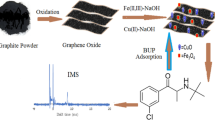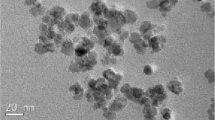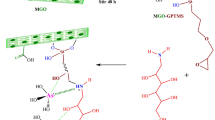Abstract
Antibiotic compounds in natural waters are normally present at low concentrations. In this paper, an easy and highly sensitive screening method using graphene oxide–functionalized magnetic composites (GO@NH2@Fe3O4) combined with matrix-assisted laser desorption/ionization-time-of-flight mass spectrometry (MALDI-TOF MS) was established for twelve quinolone antibiotics. GO@NH2@Fe3O4 composites were utilized as adsorbents for magnetic solid-phase extraction. This method combines the advantages of magnetic solid-phase extraction and MALDI-TOF MS, which allows for fast detection of quinolones at low concentrations. To improve absorption efficiency, the following parameters were individually optimized: sample acidity, extraction time, amount of adsorbent used, eluent used, and desorption time. Under the optimum conditions, the established method gave a low detection limit of 0.010 mg/L and allowed the high-throughput screening of twelve quinolone antibiotics (enoxacin, norfloxacin, ciprofloxacin, pefloxacin, fleroxacin, gatifloxacin, enrofloxacin, levofloxacin, sparfloxacin, danofloxacin, difloxacin, and lomefloxacin). The proposed method, having an easily prepared sorbent with a high affinity for quinolones and a convenient, high-throughput detection step, has been shown to have merit for the detection of antibiotics in water samples.

Schematic illustration of the (A) preparation of GO@NH2@Fe3O4 and (B) operating procedure for the MSPE and MALDI-TOF MS detection of QNs





Similar content being viewed by others
References
Pinheiro PC, Fateixa S, Nogueira HIS, Trindade T. Magnetite-supported gold nanostars for the uptake and SERS detection of tetracycline. Nanomaterials (Basel). 2018;9. https://doi.org/10.3390/nano9010031.
Hanamoto S, Nakada N, Jurgens MD, Johnson AC, Yamashita N, Tanaka H. The different fate of antibiotics in the Thames River, UK, and the Katsura River, Japan. Environ Sci Pollut Res Int. 2018;25:1903–13. https://doi.org/10.1007/s11356-017-0523-z.
Sharma VK, Johnson N, Cizmas L, McDonald TJ, Kim H. A review of the influence of treatment strategies on antibiotic resistant bacteria and antibiotic resistance genes. Chemosphere. 2016;150:702–14. https://doi.org/10.1016/j.chemosphere.2015.12.084.
Mojica E-RE. Antibiotics pollution in soil and water: potential ecological and human health issues. Encycl Environ Health. 2011:97–110. https://doi.org/10.1016/B978-0-444-52272-6.00338-X.
Danner MC, Robertson A, Behrends V, Reiss J. Antibiotic pollution in surface fresh waters: occurrence and effects. Sci Total Environ. 2019;664:793–804. https://doi.org/10.1016/j.scitotenv.2019.01.406.
Peng J, Liu L, Xu L, Song S, Kuang H, Cui G, et al. Gold nanoparticle-based paper sensor for ultrasensitive and multiple detection of 32 (fluoro)quinolones by one monoclonal antibody. Nano Res. 2016;10:108–20. https://doi.org/10.1007/s12274-016-1270-z.
Qian S, Qiao L, Xu W, Jiang K, Wang Y, Lin H. An inner filter effect-based near-infrared probe for the ultrasensitive detection of tetracyclines and quinolones. Talanta. 2019;194:598–603. https://doi.org/10.1016/j.talanta.2018.10.097.
Regulation (EC) No. 1831/2003 of the European Parliament and of the Council on additives for use in animal nutrition. 22 September, 2003.
Rusu A, Hancu G, Uivaroşi V. Fluoroquinolone pollution of food, water and soil, and bacterial resistance. Environ Chem Lett. 2014;13:21–36. https://doi.org/10.1007/s10311-014-0481-3.
Grave K, Torren-Edo J, Muller A, Greko C, Moulin G, Mackay D, et al. Variations in the sales and sales patterns of veterinary antimicrobial agents in 25 European countries. J Antimicrob Chemother. 2014;69:2284–91. https://doi.org/10.1093/jac/dku106.
Jansen LJM, Bolck YJC, Rademaker J, Zuidema T, Berendsen BJA. The analysis of tetracyclines, quinolones, macrolides, lincosamides, pleuromutilins, and sulfonamides in chicken feathers using UHPLC-MS/MS in order to monitor antibiotic use in the poultry sector. Anal Bioanal Chem. 2017;409:4927–41. https://doi.org/10.1007/s00216-017-0445-0.
Zhang Z, Li X, Ding S, Jiang H, Shen J, Xia X. Multiresidue analysis of sulfonamides, quinolones, and tetracyclines in animal tissues by ultra-high performance liquid chromatography-tandem mass spectrometry. Food Chem. 2016;204:252–62. https://doi.org/10.1016/j.foodchem.2016.02.142.
Zeng H, Chen J, Zhang C, Huang XA, Sun Y, Xu Z, et al. Broad-specificity chemiluminescence enzyme immunoassay for (fluoro)quinolones: hapten design and molecular modeling study of antibody recognition. Anal Chem. 2016;88:3909–16. https://doi.org/10.1021/acs.analchem.6b00082.
Pagani AP, Ibanez GA. Analytical approach for the simultaneous determination of quinolones in edible animal products. Modeling pH-modulated fluorescence excitation-emission matrices four-way arrays. Talanta. 2019;192:52–60. https://doi.org/10.1016/j.talanta.2018.09.015.
Kergaravat SV, Gagneten AM, Hernandez SR. Development of an electrochemical method for the detection of quinolones: application to cladoceran ecotoxicity studies. Microchem J. 2018;141:279–86. https://doi.org/10.1016/j.microc.2018.05.039.
Ashwin H, Stead S, Caldow M, Sharman M, Stark J, de Rijk A, et al. A rapid microbial inhibition-based screening strategy for fluoroquinolone and quinolone residues in foods of animal origin. Anal Chim Acta. 2009;637:241–6. https://doi.org/10.1016/j.aca.2008.08.038.
Appicciafuoco B, Dragone R, Frazzoli C, Bolzoni G, Mantovani A, Ferrini AM. Microbial screening for quinolones residues in cow milk by bio-optical method. J Pharm Biomed Anal. 2015;106:179–85. https://doi.org/10.1016/j.jpba.2014.11.037.
Karas M, Hillenkamp F. Laser desorption ionization of proteins with molecular masses exceeding 10,000 daltons. Anal Chem. 1988;60:2299–301. https://doi.org/10.1021/ac00171a028.
Guo Z, Zhang Q, Zou H, Guo B, Ni J. A method for the analysis of low-mass molecules by MALDI-TOF mass spectrometry. Anal Chem. 2002;74:1637–41. https://doi.org/10.1021/ac010979m.
Tang H-Z, Ma Y-L, Liu F, Liu F, Liu Z-W, Li J-W, et al. Detection of small molecules using SBA-15 modified CHCA as a novel matrix of MALDI-TOF MS. Int J Mass Spectrom. 2017;417:34–9. https://doi.org/10.1016/j.ijms.2017.04.004.
Saroyan H, Ntagiou D, Samanidou V, Deliyanni E. Modified graphene oxide as manganese oxide support for bisphenol A degradation. Chemosphere. 2019;225:524–34. https://doi.org/10.1016/j.chemosphere.2019.02.200.
Wang X, Liu B, Lu Q, Qu Q. Graphene-based materials: fabrication and application for adsorption in analytical chemistry. J Chromatogr A. 2014;1362:1–15. https://doi.org/10.1002/chin.201444296.
Seidi S, Majd M. Polyaniline-functionalized magnetic graphene oxide for dispersive solid-phase extraction of Cr(VI) from environmental waters followed by graphite furnace atomic absorption spectrometry. J Iran Chem Soc. 2017;14:1195–206. https://doi.org/10.1007/s13738-017-1070-8.
Maliyekkal SM, Sreeprasad TS, Krishnan D, Kouser S, Mishra AK, Waghmare UV, et al. Graphene: a reusable substrate for unprecedented adsorption of pesticides. Small. 2013;9:273–83. https://doi.org/10.1002/smll.201201125.
Cheng Z, Du F, Qin Q, Sun L, Zeng Q, Ruan G, et al. Graphene oxide composites for magnetic solid-phase extraction of trace cytokinins in plant samples followed by liquid chromatography-tandem mass spectrometry. J Sep Sci. 2018;41:2386–92. https://doi.org/10.1002/jssc.201701491.
Chen X, Hai X, Wang J. Graphene/graphene oxide and their derivatives in the separation/isolation and preconcentration of protein species: a review. Anal Chim Acta. 2016;922:1–10. https://doi.org/10.1016/j.aca.2016.03.050.
Zheng YY, Wang XB, Shang L, Li CR, Cui C, Dong WJ, et al. Fabrication of shape controlled Fe3O4 nanostructure. Mater Charact. 2010;61:489–92. https://doi.org/10.1016/j.matchar.2010.01.008.
Hartono T, Wang S, Ma Q, Zhu Z. Layer structured graphite oxide as a novel adsorbent for humic acid removal from aqueous solution. J Colloid Interface Sci. 2009;333:114–9. https://doi.org/10.1016/j.jcis.2009.02.005.
Li S, Yang D, Chen F, Liu F, Liu F, Liu Z, et al. A highly sensitive method for detection of bisphenol A in water samples based on functionalised Fe3O4@SiO2@nylon66. Int J Environ Anal Chem. 2017;97:124–33. https://doi.org/10.1080/03067319.2017.1291806.
You Q, Zhang Y, Zhang Q, Guo J, Huang W, Shi S, et al. High-capacity thermo-responsive magnetic molecularly imprinted polymers for selective extraction of curcuminoids. J Chromatogr A. 2014;1354:1–8. https://doi.org/10.1016/j.chroma.2014.05.040.
Marcano DC, Kosynkin DV, Berlin JM, Sinitskii A, Sun Z, Slesarev A, et al. Improved synthesis of graphene oxide. ACS Nano. 2010;4:4806–14. https://doi.org/10.1021/nn1006368.
Yao Y, Miao S, Liu S, Ma LP, Sun H, Wang S. Synthesis, characterization, and adsorption properties of magnetic Fe3O4@graphene nanocomposite. Chem Eng J. 2012;184:326–32. https://doi.org/10.1016/j.matpr.2017.06.169.
Smith AT, LaChance AM, Zeng S, Liu B, Sun L. Synthesis, properties, and applications of graphene oxide/reduced graphene oxide and their nanocomposites. Nano Mater Sci. 2019;1:31–47. https://doi.org/10.1016/j.nanoms.2019.02.004.
Ibarra IS, Rodriguez JA, Paez-Hernandez ME, Santos EM, Miranda JM. Determination of quinolones in milk samples using a combination of magnetic solid-phase extraction and capillary electrophoresis. Electrophoresis. 2012;33:2041–8. https://doi.org/10.1002/elps.201100559.
Jiménez-Lozano E, Marqués I, Barrón D, Beltrán JL, Barbosa J. Determination of pka values of quinolones from mobility and spectroscopic data obtained by capillary electrophoresis and a diode array detector. Anal Chim Acta. 2002;464:37–45. https://doi.org/10.1016/S0003-2670(02)00435-X.
Ferdig M, Kaleta A, Thanh Vo TD, Buchberger W. Improved capillary electrophoretic separation of nine (fluoro)quinolones with fluorescence detection for biological and environmental samples. J Chromatogr A. 2004;1047:305–11. https://doi.org/10.1016/s0021-9673(04)01102-1.
Tolls J. Sorption of veterinary pharmaceuticals in soils: a review. Environ Sci Technol. 2001;35:3397–406. https://doi.org/10.1021/es0003021.
Zhang J, Liu D, Shi Y, Sun C, Niu M, Wang R, et al. Determination of quinolones in wastewater by porous beta-cyclodextrin polymer based solid-phase extraction coupled with HPLC. J Chromatogr B Anal Technol Biomed Life Sci. 2017;1068-1069:24–32. https://doi.org/10.1016/j.jchromb.2017.09.046.
Karageorgou E, Myridakis A, Stephanou EG, Samanidou V. Multiresidue LC-MS/MS analysis of cephalosporins and quinolones in milk following ultrasound-assisted matrix solid-phase dispersive extraction combined with the quick, easy, cheap, effective, rugged, and safe methodology. J Sep Sci. 2013;36:2020–7. https://doi.org/10.1002/jssc.201300194.
Urraca JL, Castellari M, Barrios CA, Moreno-Bondi MC. Multiresidue analysis of fluoroquinolone antimicrobials in chicken meat by molecularly imprinted solid-phase extraction and high performance liquid chromatography. J Chromatogr A. 2014;1343:1–9. https://doi.org/10.1016/j.chroma.2014.03.045.
Tsai WH, Chuang HY, Chen HH, Huang JJ, Chen HC, Cheng SH, et al. Application of dispersive liquid-liquid microextraction and dispersive micro-solid-phase extraction for the determination of quinolones in swine muscle by high-performance liquid chromatography with diode-array detection. Anal Chim Acta. 2009;656:56–62. https://doi.org/10.1016/j.aca.2009.10.008.
Zhao B, Wu H, Liu Y, Tian X, Huo Y, Guan S. Magnetic solid-phase extraction based on g-C3N4/Fe3O4/MoS2 as a magnetic adsorbent for HPLC-UV determination of fluoroquinolones in chicken and eggs. Anal Methods. 2019;11:1491–9. https://doi.org/10.1039/C9AY00208A.
Funding
This work is a part of the National Key R&D Program of China (Nos. 2017YFF0211301 and 2017YFC1601101) and the Tianjin Scientific and Technology Support Program Funding Agency (No. 16YFZCNC00730).
Author information
Authors and Affiliations
Corresponding authors
Ethics declarations
The study was performed in accordance with the ethical standards.
Conflict of interest
The authors declare that they have no conflicts of interest.
Additional information
Publisher’s note
Springer Nature remains neutral with regard to jurisdictional claims in published maps and institutional affiliations.
Electronic supplementary material
ESM 1
(PDF 1505 kb)
Rights and permissions
About this article
Cite this article
Tang, Hz., Wang, Yh., Li, S. et al. Graphene oxide composites for magnetic solid-phase extraction of twelve quinolones in water samples followed by MALDI-TOF MS. Anal Bioanal Chem 411, 7039–7049 (2019). https://doi.org/10.1007/s00216-019-02081-w
Received:
Revised:
Accepted:
Published:
Issue Date:
DOI: https://doi.org/10.1007/s00216-019-02081-w




